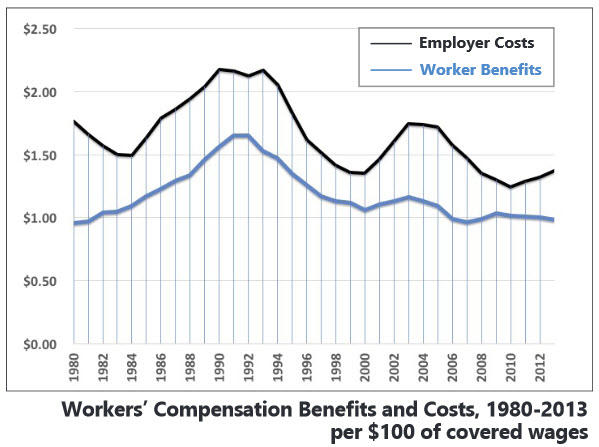Workers' compensation insurance, which covers work-related injuries, continues to get more expensive for businesses and provide lower benefits for workers. The results come from a new National Academy of Social Insurance report on workers' comp benefits, coverage and costs.
According to the analysis of data from 2009 to 2013, benefits as a percentage of payroll declined in 39 states for two major reasons, according to John F. Burton, professor emeritus of Rutgers and Cornell University, as quoted by a National Academy press release.
"The decline is due to a drop in workplace injuries as well as changes in many state laws that made it more difficult for workers' to qualify for benefits," said Burton, who was on the data study panel. "These state laws include more stringent compensation rules, the reduction of coverage for certain medical diagnoses and new legal requirements that make it more difficult for workers to succeed in their claims for benefits."
On average, injured workers received 98 cents per $100 of covered wages. Employers paid $1.37 on average per $100 of covered wages. Costs went up in 27 states.
States with the highest costs were Alaska ($2.58 per $100), Montana ($2.24) and Oklahoma ($2.24). Lowest employer costs were in the District of Columbia (47 cents per $100), Massachusetts (74 cents) and Texas (80 cents per $100). However, the inclusion of Texas requires a caveat because employers aren't required to provide workers' compensation.
Both worker benefits and business costs have been in a long-term downtrend since the early 1990s, when both were at long-term highs.
About 130 million people are under workers' comp protection. One of the big changes in expenses has been health care. In 1980, 29 percent of workers' compensation expenses were health care costs. In 2013, the percentage grew to 50 percent.
Contact the Law Office of O'Toole & Sbarbaro, P.C. today if you have a workers' compensation or a Social Security disability case.
Phone: 303-595-4777
We are located in the Denver Metro area.
226 West 12th Avenue Denver, Colorado 80204
Disclaimer
Any content of this blog is intended for informational purposes only.It is not intended to solicit business, provide legal advice from The Law Office of O'Toole & Sbarbaro, P.C. and does not serve as a medium for an attorney-client relationship. Therefore, The Law Office of O'Toole & Sbarbaro, P.C. is not responsible for the information on this blog which may not apply to every reader. Always seek professional counsel if you have any legal matters. Contents within the blog of The Law Office of O'Toole & Sbarbaro, P.C., logos and other related media are protected by the copyright laws of the United States and other jurisdictions.
Privacy Policy

